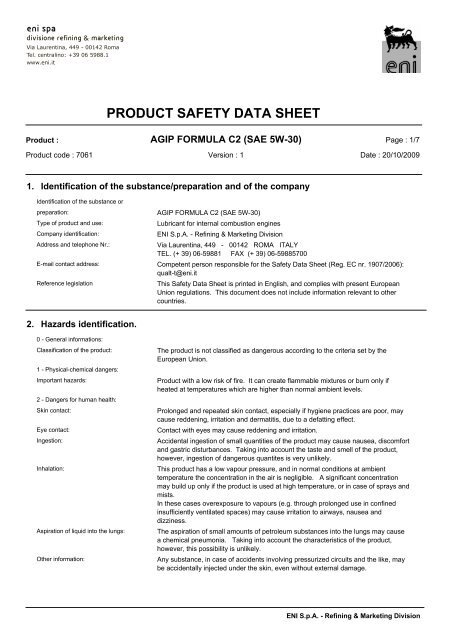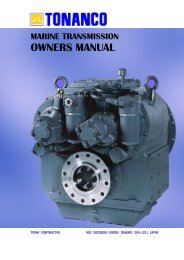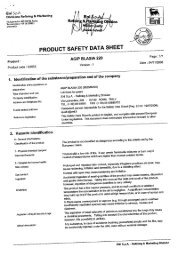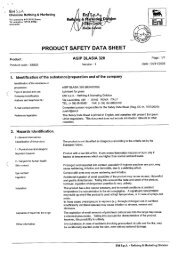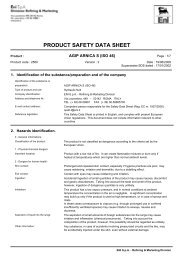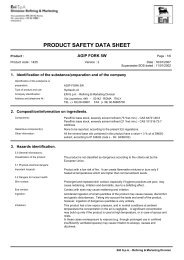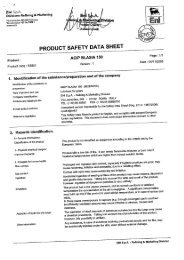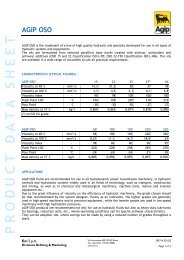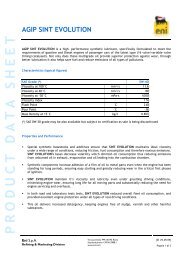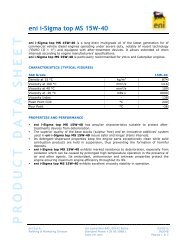AGIP FORMULA C2 (SAE 5W-30). - TransDiesel
AGIP FORMULA C2 (SAE 5W-30). - TransDiesel
AGIP FORMULA C2 (SAE 5W-30). - TransDiesel
You also want an ePaper? Increase the reach of your titles
YUMPU automatically turns print PDFs into web optimized ePapers that Google loves.
Via Laurentina, 449 - 00142 Roma<br />
Tel. centralino: +39 06 5988.1<br />
www.eni.it<br />
PRODUCT SAFETY DATA SHEET<br />
Product :<br />
Product code : 7061<br />
<strong>AGIP</strong> <strong>FORMULA</strong> <strong>C2</strong> (<strong>SAE</strong> <strong>5W</strong>-<strong>30</strong>)<br />
Version : 1<br />
Page : 1/7<br />
Date : 20/10/2009<br />
1. Identification of the substance/preparation and of the company<br />
Identification of the substance or<br />
preparation:<br />
Type of product and use:<br />
Company identification:<br />
Address and telephone Nr.:<br />
<strong>AGIP</strong> <strong>FORMULA</strong> <strong>C2</strong> (<strong>SAE</strong> <strong>5W</strong>-<strong>30</strong>)<br />
Lubricant for internal combustion engines<br />
ENI S.p.A. - Refining & Marketing Division<br />
Via Laurentina, 449 - 00142 ROMA ITALY<br />
TEL. (+ 39) 06-59881 FAX (+ 39) 06-59885700<br />
E-mail contact address: Competent person responsible for the Safety Data Sheet (Reg. EC nr. 1907/2006):<br />
qualt-t@eni.it<br />
Reference legislation<br />
This Safety Data Sheet is printed in English, and complies with present European<br />
Union regulations. This document does not include information relevant to other<br />
countries.<br />
2. Hazards identification.<br />
0 - General informations:<br />
Classification of the product:<br />
1 - Physical-chemical dangers:<br />
Important hazards:<br />
2 - Dangers for human health:<br />
Skin contact:<br />
Eye contact:<br />
Ingestion:<br />
Inhalation:<br />
Aspiration of liquid into the lungs:<br />
Other information:<br />
The product is not classified as dangerous according to the criteria set by the<br />
European Union.<br />
Product with a low risk of fire. It can create flammable mixtures or burn only if<br />
heated at temperatures which are higher than normal ambient levels.<br />
Prolonged and repeated skin contact, especially if hygiene practices are poor, may<br />
cause reddening, irritation and dermatitis, due to a defatting effect.<br />
Contact with eyes may cause reddening and irritation.<br />
Accidental ingestion of small quantities of the product may cause nausea, discomfort<br />
and gastric disturbances. Taking into account the taste and smell of the product,<br />
however, ingestion of dangerous quantites is very unlikely.<br />
This product has a low vapour pressure, and in normal conditions at ambient<br />
temperature the concentration in the air is negligible. A significant concentration<br />
may build up only if the product is used at high temperature, or in case of sprays and<br />
mists.<br />
In these cases overexposure to vapours (e.g. through prolonged use in confined<br />
insufficiently ventilated spaces) may cause irritation to airways, nausea and<br />
dizziness.<br />
The aspiration of small amounts of petroleum substances into the lungs may cause<br />
a chemical pneumonia. Taking into account the characteristics of the product,<br />
however, this possibility is unlikely.<br />
Any substance, in case of accidents involving pressurized circuits and the like, may<br />
be accidentally injected under the skin, even without external damage.<br />
ENI S.p.A. - Refining & Marketing Division
PRODUCT SAFETY DATA SHEET<br />
Product :<br />
Product code : 7061<br />
<strong>AGIP</strong> <strong>FORMULA</strong> <strong>C2</strong> (<strong>SAE</strong> <strong>5W</strong>-<strong>30</strong>)<br />
Version : 1<br />
Page : 2/7<br />
Date : 20/10/2009<br />
3 - Environmental hazards:<br />
Important hazards:<br />
In such a case, the victim should be brought to an hospital as soon as possible, to<br />
get specialized medical treatment.<br />
This product is not classified as dangerous to the environment, according to the<br />
criteria set by the EU.<br />
3. Composition/information on ingredients.<br />
Components: Paraffinic base stock, hydroisomerized (49 % wt min) - CAS 72623-87-1<br />
Synthetic base stock.<br />
Additives<br />
Hazardous component(s):<br />
Other information:<br />
Alkylphenol-hydroxyphenylpropionate from C14-C15 alcohols 1.95 %wt max (CAS<br />
171090-93-0; R 53)<br />
Zinc alkyldithiophosphate 0.95 % wt max (EINECS 272-028-3; Xi, N; R 38-41-51/53)<br />
All the mineral base oils contained in this product have a value < 3 % wt of DMSO<br />
extract, according to IP 346/92 (note L - Dir. 94/69/CE)<br />
4. First aid measures.<br />
Skin contact:<br />
Eye contact:<br />
Ingestion:<br />
Inhalation:<br />
Aspiration of liquid into the lungs:<br />
Take off contaminated clothing and shoes. Wash thoroughly with soap and water.<br />
If inflammation or irritation persists, seek medical advice.<br />
Rinse eyes thoroughly for at least 10 minutes. Keep eyelids well apart.<br />
If irritation persists, seek medical advice.<br />
Do not induce vomiting to avoid aspiration into the lungs. If the person is conscious,<br />
rinse mouth with water without swallowing. Keep at rest. Call for medical assistance<br />
or bring to an hospital.<br />
In case of disturbances owing to an exposure to a high concentration of vapours or<br />
mists, remove the victim from exposure; keep at rest; if necessary, seek medical<br />
attention.<br />
If there is the possibility that the product has been aspired into the lungs (i.e. in case<br />
of spontaneous vomiting), transport the victim to a hospital.<br />
5. Fire-fighting measures.<br />
General information:<br />
Extinguishing media:<br />
Shut off source of product, if possible.<br />
If possible, move containers and drums away from danger area.<br />
- Suitable: Small-size fires: carbon dioxide, dry chemicals, foam, sand or earth.<br />
Large fires: foam or water fog (mist). These means should be used by trained<br />
personnel only.<br />
- Not to be used: Do not use water jets. They could cause splattering, and spread the fire.<br />
Special protective equipment for firefighters: Personal protection equipment.<br />
Self-contained breathing apparatus<br />
Useful precautions:<br />
Other information:<br />
Avoid accidental sprays on hot surfaces or electrical contacts.<br />
In case of losses from pressurized circuits, the sprays may form mists. Take into<br />
account that in this case the lower explosion limit for mists is about 45 g/m³ air.<br />
Use water sprays to cool the surfaces exposed to the flames.<br />
Spilled product which is not burning should be covered with sand or foam<br />
ENI S.p.A. - Refining & Marketing Division
PRODUCT SAFETY DATA SHEET<br />
Product :<br />
Product code : 7061<br />
<strong>AGIP</strong> <strong>FORMULA</strong> <strong>C2</strong> (<strong>SAE</strong> <strong>5W</strong>-<strong>30</strong>)<br />
Version : 1<br />
Page : 3/7<br />
Date : 20/10/2009<br />
In case of fire, do not discharge runoff water: collect separately and use a proper<br />
treatment.<br />
6. Accidental release measures.<br />
General measures:<br />
Personal precautions:<br />
Methods for cleaning up:<br />
Shut off source of spill, if possible.<br />
Eliminate sources of ignition.<br />
Do not let the product flow into sewers, water courses or underground spaces.<br />
Notify local authorities according to relevant regulations.<br />
See Sect. 8 of this sheet.<br />
- Soil: Contain spilled liquid with sand, earth or other suitable absorbents. Recover free<br />
liquid and waste materials in suitable waterproof and oil-resistant containers. Clean<br />
contaminated area. Dispose of according to local regulations.<br />
- Water: Confine the spillage. Remove from surface by skimming or suitable absorbents.<br />
Collect recovered product and other waste materials in suitable waterproof, oil<br />
resistant containers. Recover or dispose of according to local regulations.<br />
Do not use solvents or dispersants.<br />
7. Handling and storage.<br />
Storage:<br />
Handling:<br />
Keep away from sources of ignition.<br />
Storage temperature: ambient to 55°C max .<br />
Store in a well ventilated place.<br />
Store the product in cool, well ventilated surroundings<br />
Avoid proximity or contact with hot surfaces, flames or sparks.<br />
Avoid contact with skin<br />
Do not breathe vapours or mists.<br />
Do not smoke.<br />
Do not cut, weld, drill, burn or incinerate empty containers or drums, unless they<br />
have been cleaned, and declared safe.<br />
8. Exposure controls/personal protection.<br />
General indications:<br />
8.1 Exposure limit values<br />
Exposure limits:<br />
Monitoring procedures:<br />
8.2 Control of exposure<br />
General informations:<br />
Avoid excessive or improper use.<br />
Avoid the creation of mists or vapours.<br />
For the control of exposure to the product, the most relevant exposure limits are<br />
listed here.<br />
TLV-TWA (A.C.G.I.H. 2008): 5 mg/m³ (mineral oil mists)<br />
TLV-STEL (A.C.G.I.H. 2008): 10 mg/m³ (mineral oil mists)<br />
If necessary, take into account the other limits listed in the relevant workplace<br />
regulations, or in the ACGIH documents.<br />
Refer to relevant legislation and in any case to the good practice of industrial<br />
hygiene.<br />
In case the concentration of the product or any constituent is above the exposure<br />
limits, and if plant characteristics, work procedures and other means are not able to<br />
ENI S.p.A. - Refining & Marketing Division
PRODUCT SAFETY DATA SHEET<br />
Product :<br />
Product code : 7061<br />
<strong>AGIP</strong> <strong>FORMULA</strong> <strong>C2</strong> (<strong>SAE</strong> <strong>5W</strong>-<strong>30</strong>)<br />
Version : 1<br />
Page : 4/7<br />
Date : 20/10/2009<br />
reach the purpose, it is necessary to use suitable means of personal protection.<br />
Respiratory protection:<br />
Personal protection:<br />
Hygiene measures:<br />
Open or well ventilated areas: not necessary.<br />
Closed or confined areas (e.g. tank interiors): self-contained breathing apparatus.<br />
Long-sleeved overalls. If necessary, refer to the EN 943-1<strong>30</strong>34-14605 standards<br />
When there is a risk of contact with the eyes, use safety goggles or other means of<br />
protection. If necessary, refer to national standards or to the EN 166 standard.<br />
When there is a risk of contact with the skin, use hydrocarbon-resistant, felt-lined<br />
gloves.<br />
Experience shows that gloves made of Nitrile rubber or PVA (Polyvinylalcohol) are<br />
adequate for this use.<br />
Gloves made of PVC can be used for limited periods.<br />
Gloves made of Neoprene or natural rubber (latex) have inadequate resistance.<br />
Use gloves respecting all the conditions and within the limits set by the manufacturer.<br />
Replace gloves immediately in case of cuts, holes or other signs of damages or<br />
degradation.<br />
If necessary, refer to the EN 374 standard.<br />
Avoid contact with skin and eyes<br />
Do not breathe vapours or mists.<br />
Do not clean hands with dirty or oil-soaked rags.<br />
Do not keep dirty rags in the overall pockets.<br />
Do not drink, eat or smoke with dirty hands.<br />
Wash hands with water and soap, do not use solvents or other irritant products<br />
which have a defatting effect on the skin.<br />
Do not re-use clothes, if they are still contaminated.<br />
9. Physical and chemical properties (typical values).<br />
Appearance: Liquid, bright & clear (ASTM D 4176/1).<br />
Odour:<br />
Characteristic.<br />
Colour Not determined (ASTM D 1500)<br />
Density a 15°C: 855 kg/m³ (ASTM D 1298).<br />
Boiling point/range: > 200 °C (at 10 mmHg) (ASTM D 1160)<br />
Vapour pressure:<br />
1·10-3 hPa (20 °C)<br />
Viscosity at 40°C: N.D. (ASTM D 445).<br />
Viscosity at 100°C : 10 mm²/s (ASTM D 445).<br />
Solubility in water:<br />
Insoluble in water<br />
pH : Not applicable (ASTM D 1287).<br />
Pour point: -<strong>30</strong> °C. (ASTM D 97)<br />
Flash point : 215 °C. (ASTM D 92)<br />
Auto-ignition temperature: > <strong>30</strong>0 °C (DIN 51794)<br />
Explosion limits:<br />
- Lower: Not determined.<br />
- Upper: Not determined.<br />
Partition coefficient (P o/w):<br />
Not determined.<br />
DMSO extract of base stock: < 3 % wt (IP 346/92)<br />
ENI S.p.A. - Refining & Marketing Division
PRODUCT SAFETY DATA SHEET<br />
Product :<br />
Product code : 7061<br />
<strong>AGIP</strong> <strong>FORMULA</strong> <strong>C2</strong> (<strong>SAE</strong> <strong>5W</strong>-<strong>30</strong>)<br />
Version : 1<br />
Page : 5/7<br />
Date : 20/10/2009<br />
10. Stability and reactivity.<br />
Thermal decomposition products:<br />
Stability:<br />
Hazardous reactions:<br />
Materials to avoid:<br />
HC, COx, NOx, SOx, H2S, POx<br />
Stable product.<br />
None<br />
Strong oxidants<br />
11. Toxicological information.<br />
Oral toxicity (rat):<br />
Dermal toxicity (rabbit):<br />
Inhalation toxicity (rat):<br />
Skin sensitization:<br />
Other information:<br />
LD50 greater than 2000 mg/kg (estimated from the composition)<br />
LD50 greater than 2000 mg/kg (estimated from the composition)<br />
LC50 greater than 5 mg/l/4h (estimated from the composition)<br />
Contains a sensitizer (calcium sulphonate) in an amount > 0.1 % wt (Ref.: Dir.<br />
1999/45/CE)<br />
The product is not classified as a sensitizer according to the criteria set by the EU.<br />
(Refers to active component).<br />
* Not irritating to eyes and skin<br />
* Minor irritation may occur after prolonged or repeated contact, especially if normal<br />
hygienic rules are not respected.<br />
* None of the components of this product are listed as carcinogen by NTP, IARC,<br />
OSHA, EU or others.<br />
12. Ecological information.<br />
General informations:<br />
Biodegradation:<br />
Toxicity for aquatic organisms:<br />
Other data:<br />
WGK class (Germany): 1<br />
Handle according to general working hygiene practices to avoid pollution and<br />
release into the environment.<br />
The most significant constituents of the product should be considered as "inherently<br />
biodegradable", but not "readily biodegradable", and they may be moderately<br />
persistent, particularly in anaerobic conditions.<br />
This product is not soluble in water. It floats on water and forms a film on the<br />
surface. The damage to aquatic organisms is of mechanical kind (immobilization and<br />
entrapment)<br />
No specific environmental data are available for this product.<br />
According to the components, and by comparison with other products of the same<br />
type and composition, it is expected that this product has a toxicity for aquatic<br />
organisms > 100 mg/l, and must not be regarded as dangerous to the environment.<br />
This product has no specific properties for inhibition of bacterial activity.<br />
In any case, wastewater containing this product should be treated in plants that are<br />
suited for the specific purpose.<br />
13. Disposal considerations.<br />
Disposal of product:<br />
European Waste Catalogue Code:<br />
Do not dispose of the product, either new or used, by discharging into sewers,<br />
tunnels, lakes or water courses. Deliver to a qualified official collector.<br />
13 02 05 (Ref: 2001/118/CE)<br />
This code is only a general indication, and takes into account the original composition<br />
ENI S.p.A. - Refining & Marketing Division
PRODUCT SAFETY DATA SHEET<br />
Product :<br />
Product code : 7061<br />
<strong>AGIP</strong> <strong>FORMULA</strong> <strong>C2</strong> (<strong>SAE</strong> <strong>5W</strong>-<strong>30</strong>)<br />
Version : 1<br />
Page : 6/7<br />
Date : 20/10/2009<br />
Disposal of packaging:<br />
of the product and its intended use. The user has the responsibility of choosing the<br />
right code, considering the actual use of the product, alterations and contaminations.<br />
Dispose of in a safe manner, in accordance with local regulations.<br />
Do not cut, weld, drill, burn or incinerate empty containers or drums, unless they<br />
have been cleaned, and declared safe.<br />
14. Transport information.<br />
Transport hazard label:<br />
International denomination :<br />
Substance identification number. (UN Nr.):<br />
RID/ADR:<br />
ICAO/IATA:<br />
IMO-IMDG code:<br />
Not applicable.<br />
Not applicable.<br />
Not applicable.<br />
Does not belong to any class of danger.<br />
Does not belong to any class of danger.<br />
Does not belong to any class of danger.<br />
15. Regulatory information.<br />
EU labelling information:<br />
Other indications:<br />
Applicable laws and regulations:<br />
Not classified under this legislation.<br />
Additional indication on containers (Ref.: Dir. 1999/45/CE):<br />
"Contains calcium sulphonate. May produce an allergic reaction"<br />
National laws on classification and labeling of dangerous substances/preparations<br />
(Adoption of Directive 67/548/CE and subsequent Adaptations to Technical<br />
Progress - ATP, and Directive 1999/45/CE).<br />
Relevant national laws on health and safety on the workplace.<br />
National adoption of Directives 89/391/CEE, 89/654/CEE, 89/655/CEE, 89/656/CEE,<br />
90/269/CEE, 90/270/CEE, 90/394/CEE, 90/679/CEE, 93/88/CEE, 95/63/CE,<br />
97/42/CE, 98/24/CE, 99/38/CE, 99/92/CE, 2001/45/CE, 2003/10/CE, 2003/18/CE.<br />
National adoption of Directive 75/439/CEE concerning disposal of used oils.<br />
Relevant national laws on recycling and re-use of waste materials.<br />
Relevant national laws on prevention of water pollution.<br />
16. Other information.<br />
General indications:<br />
Other uses of the product:<br />
Document references:<br />
Text of R-phrases:<br />
Laboratory tests on animals have shown that engine oils undergo changes during<br />
usage, and risks increase, compared with fresh oils.<br />
Therefore, it is very important to follow the above mentioned precautionary<br />
measures also with used oils.<br />
Avoid excessive or improper use.<br />
Do not use the product for any purposes that have not been advised by the<br />
manufacturer. In that case, the user could be exposed to unforeseeable dangers.<br />
This Safety Data Sheets conforms to the dispositions of Regulation (EC) No<br />
1907/2006 (REACH).<br />
Complete text of the R-phrases quoted in this Safety Sheet. These phrases are<br />
reported here for information only, and MAY NOT correspond to the classification of<br />
the product.<br />
R 38: Irritating to skin.<br />
R 41: Risk of serious damage to eyes.<br />
R 51/53: Toxic to aquatic organisms, may cause long-term adverse effects in the<br />
aquatic environment.<br />
ENI S.p.A. - Refining & Marketing Division
PRODUCT SAFETY DATA SHEET<br />
Product :<br />
Product code : 7061<br />
<strong>AGIP</strong> <strong>FORMULA</strong> <strong>C2</strong> (<strong>SAE</strong> <strong>5W</strong>-<strong>30</strong>)<br />
Version : 1<br />
Page : 7/7<br />
Date : 20/10/2009<br />
Nature of revision:<br />
R 52/53: Harmful to aquatic organisms, may cause long-term adverse effects in the<br />
aquatic environment.<br />
First issue.<br />
This information relates only to the specific product and may not be valid if the product is used in combination with any other material<br />
or in any process.<br />
The informations in this sheet are according to our best knowledge at the date of printing.<br />
This Safety Data Sheet has been checked and printed on 20/10/2009.<br />
End of document. Number of page(s) : 7<br />
ENI S.p.A. - Refining & Marketing Division


